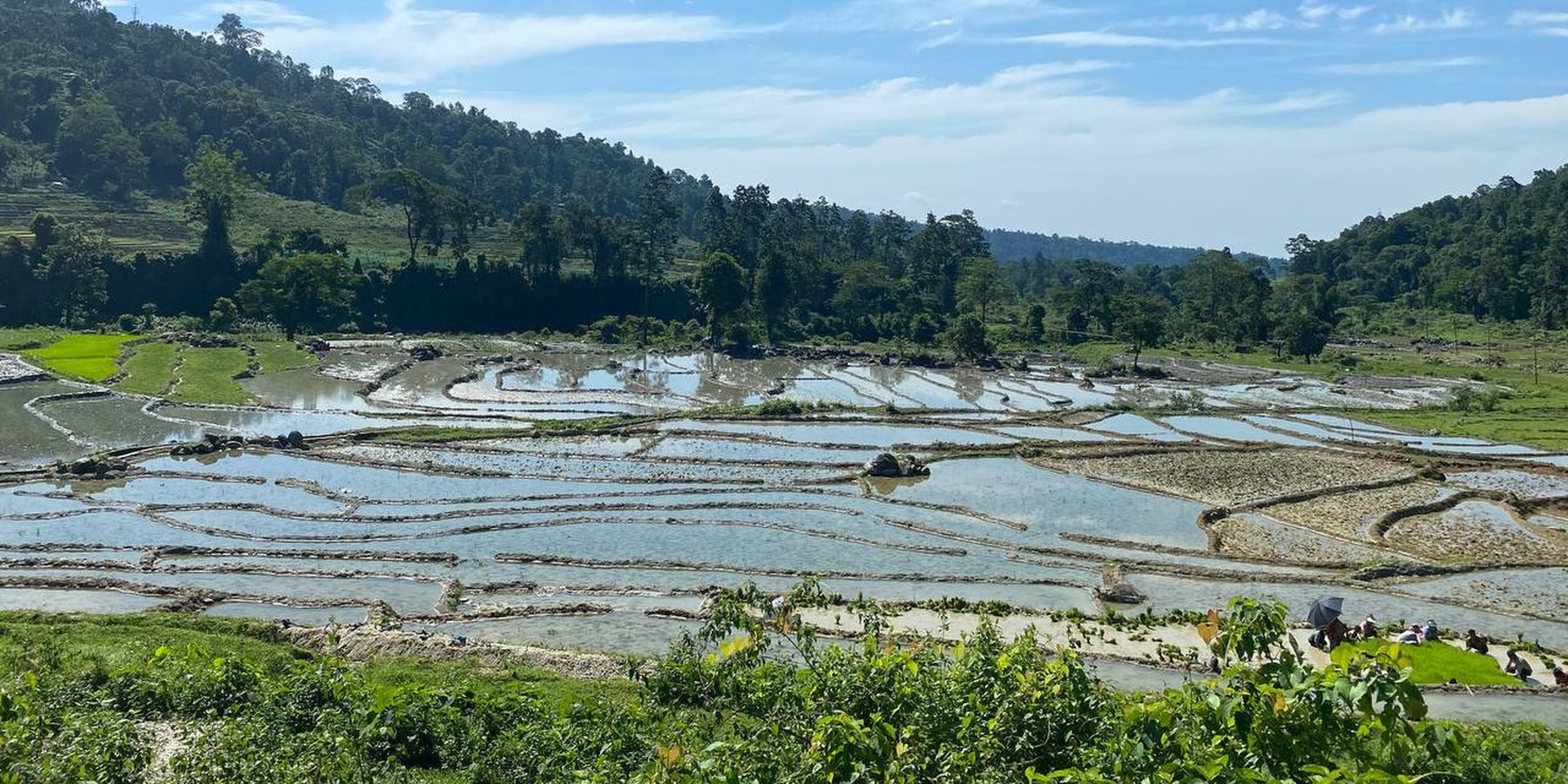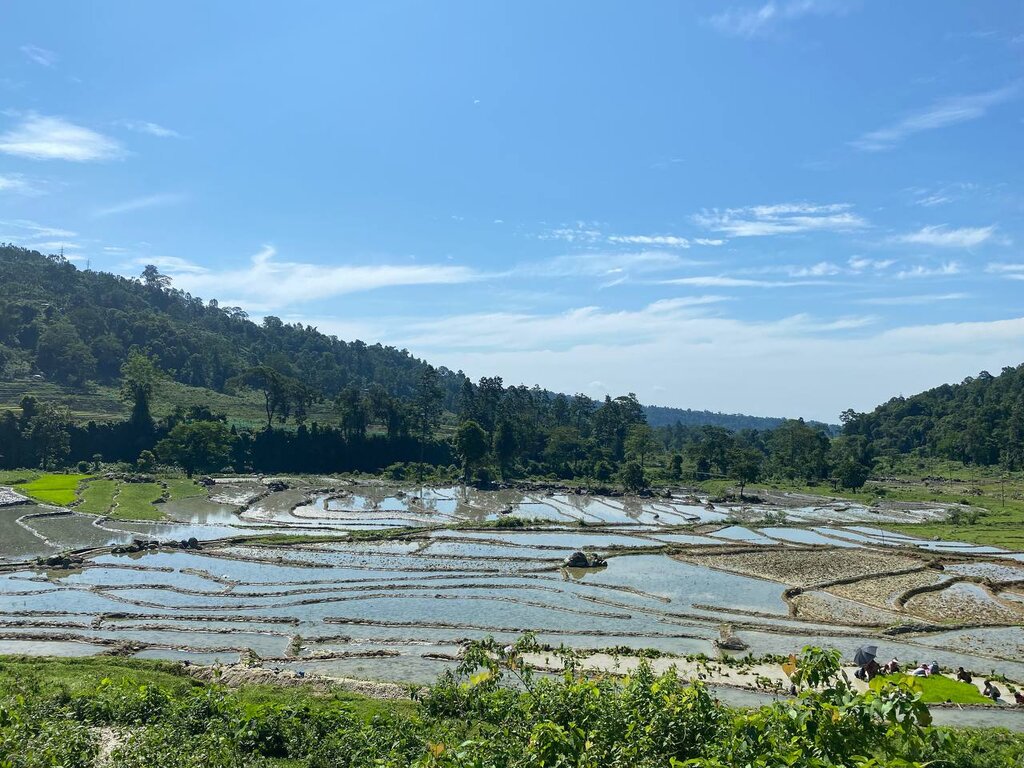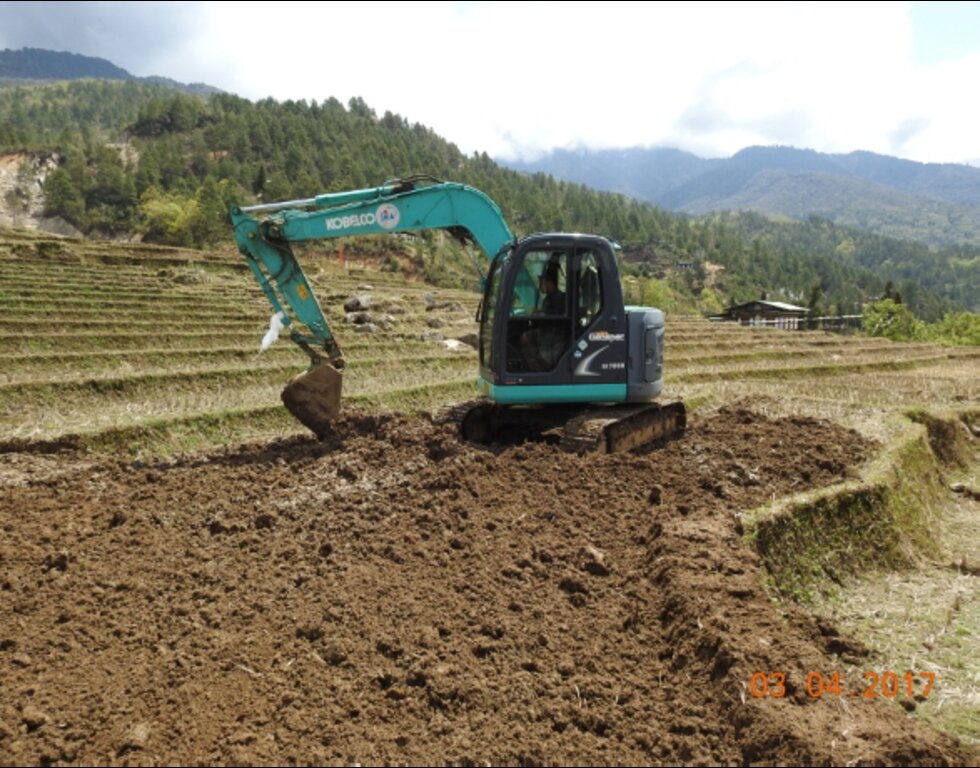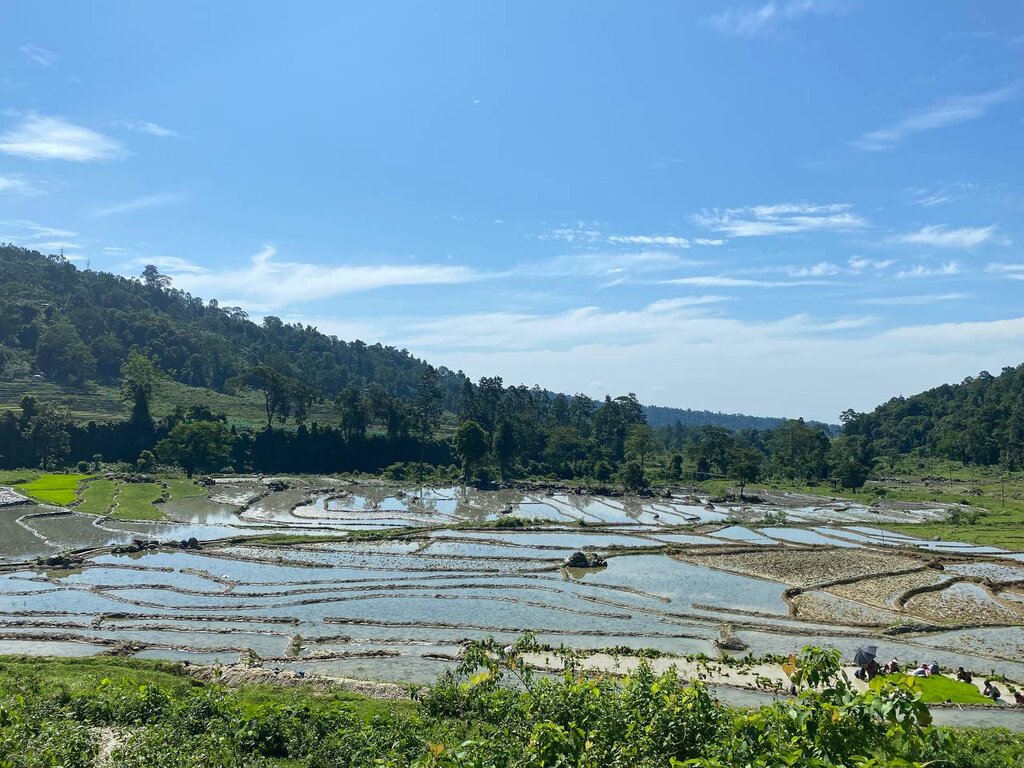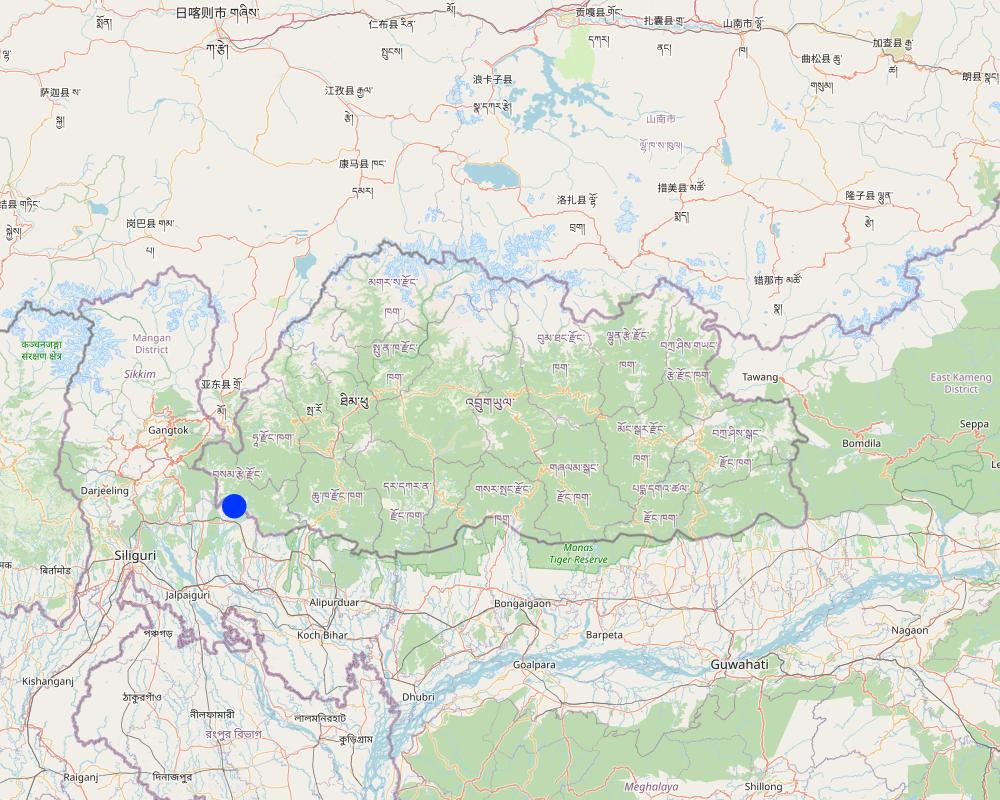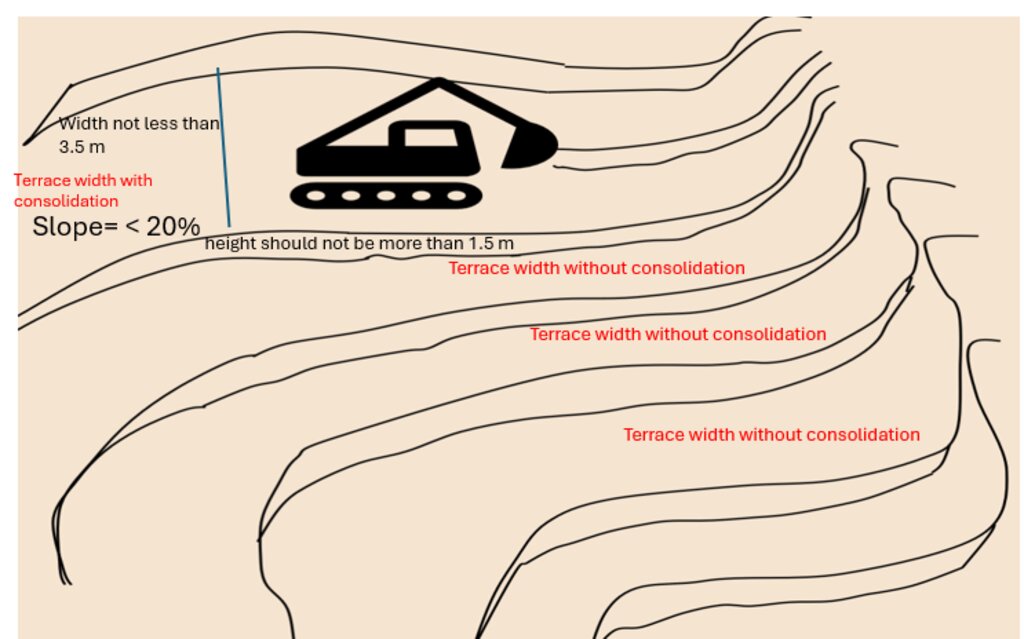Terrace Consolidation by Machine [不丹]
- 创建:
- 更新:
- 编制者: Karma Wangdi
- 编辑者: Tashi Wangdi
- 审查者: William Critchley, Rima Mekdaschi Studer, Joana Eichenberger
Thruel Chhey Lag Len Thap Tey Aring Ja Kaed Tang Ni (ཁྲུལ་ཆས་ཐོག་ཨ་རིང་བརྒྱ་སྐྱེད་བཏང་ནི།)
technologies_6871 - 不丹
查看章节
全部展开 全部收起1. 一般信息
1.2 参与该技术评估和文件编制的资源人员和机构的联系方式
关键资源人
土地使用者:
Limbu Ram Bahadur
Sang-Ngag-Chhoeling village, Yoeseltse Gewog (Block), Samtse Dzongkhag (District)
不丹
有助于对技术进行记录/评估的项目名称(如相关)
Strengthening national-level institutional and professional capacities of country Parties towards enhanced UNCCD monitoring and reporting – GEF 7 EA Umbrella II (GEF 7 UNCCD Enabling Activities_Umbrella II)有助于对技术进行记录/评估的机构名称(如相关)
National Soil Services Centre, Department of Agriculture, Ministry of Agriculture & Livestock (NSSC) - 不丹1.3 关于使用通过WOCAT记录的数据的条件
编制者和关键资源人员接受有关使用通过WOCAT记录数据的条件。:
是
1.4 所述技术的可持续性声明
这里所描述的技术在土地退化方面是否存在问题,导致无法被认为是一种可持续的土地管理技术?:
否
注释:
This technology is one of the major land degradation mitigating measures
2. SLM技术的说明
2.1 技术简介
技术定义:
Terrace consolidation is the merging of existing narrow bench terraces into larger terraces to enable farm mechanization, commercial farming and crop intensification. This technology is promoted as the existing terraces are generally narrow and this limits efficient operation and utilization of land and other resources.
2.2 技术的详细说明
说明:
Terrace consolidation involves merging of small terraces into larger terraces using a machine to make more efficient use of land through farm mechanization, commercial farming and crop intensification. This technology is promoted as the existing terraces are generally narrow and this limits efficient operation and utilization of land and other resources.
The consolidation of narrow terraces is recommended if the general slope of the proposed site is less than 20° (36%) with good soil drainage and low risk of land degradation. While consolidating narrow terraces, it is strongly recommended to remove the topsoil from the terraces and put it back once the levelling is completed. The consolidated terrace should maintain a maximum riser height of 1.5 m and bed width of 3.5 m. For slopes below 12° (21%), the bench width should not exceed 5–6 m.
Farmers can expand the amount of arable land available, maximize agricultural operations, and encourage sustainable farming methods for higher crop output and enhanced ecological resilience by converting narrower and more steep bench terraces into bigger ones (NSSC, 2020). A large portion of hillside farmers around the world rely on terracing. For the purpose of facilitating the growth of field crops, horticultural crops, fodder, and other crops that require specific management practices (e.g., irrigation), alone or in agroforestry systems, hilly or mountainous terrains are divided into narrow but graduated steps, typically 2-3 m wide and 50-80 m long across the slopes (Chapagain & Raizada, 2017).
Enlargement of terraces begins with a thorough survey and analysis of the topography and terrain. In order to build larger terraces with the least amount of environmental damage, this phase is essential. The next step in the construction process is to reshape the present, small terraces into larger, more open ones. To make wider terraced levels, this may entail moving soil and cutting through slopes. Furthermore, filling up the gaps and levelling the land's surface is required in order to reduce the number of risers and produce a continuous, gently sloping terrace. The installation of suitable drainage systems is also crucial to guarantee adequate water management and stop soil erosion.
Larger terraces enhance water management capabilities. With a more extensive surface area, water runoff is minimized, and the distribution of irrigation water becomes more even, promoting better soil moisture retention and reducing erosion. This, in turn, contributes to soil health and fertility, supporting sustainable farming practices. Moreover, the consolidation of smaller terraces into larger ones reduces the overall number of risers, thereby enhancing accessibility for farmworkers and farm machinery. This ease of access further optimizes the use of resources and fosters better crop management. Additionally, larger terraces can enable the implementation of crop diversification strategies, such as intercropping and crop rotation, promoting biodiversity and mitigating the risk of crop failure due to pests or adverse weather conditions.
However, the process of enlarging terraces involves altering the terrain, which can lead to soil erosion, habitat destruction, and ecological imbalances. This environmental impact may negatively affect local flora and fauna, reducing biodiversity and disrupting the delicate ecological equilibrium (Deng et al., 2021). Planning for safe discharge of excess water out of the terrace system effectively helps preserve soil fertility and reduces runoff. It is essential also to pay close attention to the preservation of the local ecosystem and biodiversity throughout the process.
2.3 技术照片
2.5 已应用该技术的、本评估所涵盖的国家/地区/地点
国家:
不丹
区域/州/省:
Samtse
有关地点的进一步说明:
Sang-Ngag-Chhoeling
具体说明该技术的分布:
- 均匀地分布在一个区域
如果不知道精确的区域,请注明大致覆盖的区域:
- < 0.1 平方千米(10 公顷)
技术现场是否位于永久保护区?:
否
注释:
Total area is 6 hectares
Map
×2.6 实施日期
注明实施年份:
2021
2.7 技术介绍
详细说明该技术是如何引入的:
- 通过项目/外部干预
注释(项目类型等):
The terrace consolidation activities in this community was funded by the Green Climate Fund (GCF) project for Land Consolidation
3. SLM技术的分类
3.1 该技术的主要目的
- 改良生产
- 减少、预防、恢复土地退化
- 适应气候变化/极端天气及其影响
- 减缓气候变化及其影响
- 创造有益的经济影响
3.2 应用该技术的当前土地利用类型
同一土地单元内混合使用的土地::
否

农田
- paddy
每年的生长季节数:
- 1
采用间作制度了吗?:
否
采用轮作制度了吗?:
否
3.3 由于技术的实施,土地使用是否发生了变化?
由于技术的实施,土地使用是否发生了变化?:
- 否(继续问题3.4)
同一土地单元内混合使用的土地::
否

农田
- paddy
采用间作制度了吗?:
否
采用轮作制度了吗?:
否

定居点、基础设施
- 定居点、建筑物
- 交通:公路、铁路
- 能源:管道、电线

不毛之地
3.4 供水
该技术所应用土地的供水:
- 混合雨水灌溉
3.5 该技术所属的SLM组
- 横坡措施
- 湿地保护/管理
- 减少基于生态系统的灾害风险
3.6 包含该技术的可持续土地管理措施

结构措施
- S1:阶地
- S2:堤、岸
3.7 该技术强调的主要土地退化类型

土壤水蚀
- Wt:表土流失/地表侵蚀
- Wg:冲沟侵蚀/沟蚀
3.8 防止、减少或恢复土地退化
具体数量名该技术与土地退化有关的目标:
- 减少土地退化
- 适应土地退化
4. 技术规范、实施活动、投入和成本
4.1 该技术的技术图纸
技术规范(与技术图纸相关):
consolidation of old and small terraces with machines
作者:
karma Wangdi
日期:
20/07/2023
4.2 有关投入和成本计算的一般信息
具体说明成本和投入是如何计算的:
- 每个技术区域
注明尺寸和面积单位:
2.5 acre
如果使用本地面积单位,注明转换系数为1公顷(例如1公顷=2.47英亩):1公顷=:
1ha
其它/国家货币(具体说明):
Ngultrum
如相关,注明美元与当地货币的汇率(例如1美元=79.9巴西雷亚尔):1美元=:
80.0
注明雇用劳工的每日平均工资成本:
500
4.3 技术建立活动
| 活动 | 时间(季度) | |
|---|---|---|
| 1. | Secure funding support from GCF | January (Before cropping) |
| 2. | Action planning in consultation with beneficiaries and the stakeholders | February (Before cropping) |
| 3. | Arrangement of excavator machine | First week of March (Before cropping) |
| 4. | Activity implementation | Second week of March till April (Before cropping) |
4.4 技术建立所需要的费用和投入
| 对投入进行具体说明 | 单位 | 数量 | 单位成本 | 每项投入的总成本 | 土地使用者承担的成本% | |
|---|---|---|---|---|---|---|
| 劳动力 | Assisting operator (reaching fuel) | no | 60.0 | 500.0 | 30000.0 | 100.0 |
| 劳动力 | Labelling of terraces | no | 60.0 | 500.0 | 30000.0 | 100.0 |
| 设备 | Hiring of Excavator | day | 6.0 | 20000.0 | 120000.0 | |
| 技术建立所需总成本 | 180000.0 | |||||
| 技术建立总成本,美元 | 2250.0 | |||||
如果土地使用者负担的费用少于100%,请注明由谁负担其余费用:
This technology is been supported and funded by Green Climate Fund for land consolidation
注释:
consolidation of old terraces is recommended only if the general slope of the proposed site is less than 20% with good soil drainage and minimal risk of land degradation. While consolidating small terraces into large terraces, the new terrace riser height should not be more than 1.5 m and width of the bench not less than 3.5 .For one ha there are around 34 small terrace which is consolidated to 18 terraces.
4.5 维护/经常性活动
注释:
No maintenance is done until now
4.6 维护/经常性活动所需要的费用和投入(每年)
注释:
Till date no maintenance was done
4.7 影响成本的最重要因素
描述影响成本的最决定性因素:
The major factor affecting the cost for implementing this technology is in hiring of excavator
5. 自然和人文环境
5.1 气候
年降雨量
- < 250毫米
- 251-500毫米
- 501-750毫米
- 751-1,000毫米
- 1,001-1,500毫米
- 1,501-2,000毫米
- 2,001-3,000毫米
- 3,001-4,000毫米
- > 4,000毫米
指定年平均降雨量(若已知),单位为mm:
1500.00
有关降雨的规范/注释:
The gewog experiences mostly heavy shower with annual rainfall ranging from 1500 mm to 4000 mm
注明所考虑的参考气象站名称:
National Center for Hydrology and Metrology (NCHM), Bhutan
农业气候带
- 半湿润
Subtropical monsoon climatic zone
5.2 地形
平均坡度:
- 水平(0-2%)
- 缓降(3-5%)
- 平缓(6-10%)
- 滚坡(11-15%)
- 崎岖(16-30%)
- 陡峭(31-60%)
- 非常陡峭(>60%)
地形:
- 高原/平原
- 山脊
- 山坡
- 山地斜坡
- 麓坡
- 谷底
垂直分布带:
- 0-100 m a.s.l.
- 101-500 m a.s.l.
- 501-1,000 m a.s.l.
- 1,001-1,500 m a.s.l.
- 1,501-2,000 m a.s.l.
- 2,001-2,500 m a.s.l.
- 2,501-3,000 m a.s.l.
- 3,001-4,000 m a.s.l.
- > 4,000 m a.s.l.
说明该技术是否专门应用于:
- 不相关
5.3 土壤
平均土层深度:
- 非常浅(0-20厘米)
- 浅(21-50厘米)
- 中等深度(51-80厘米)
- 深(81-120厘米)
- 非常深(> 120厘米)
如有可能,附上完整的土壤描述或具体说明可用的信息,例如土壤类型、土壤酸碱度、阳离子交换能力、氮、盐度等。:
Soil Type: Sandy Loam
MC (%): 3.66
OM (%): 1.73
OC (%): 1.00
pH (H20): 6.60
EC (µs/cm): 28.37
N (%): 0.05
P (ppm): 0.73
K (mg/100ml): 82.77
5.4 水资源可用性和质量
地表水的可用性:
好
水质(未处理):
良好饮用水
水的盐度有问题吗?:
否
该区域正在发生洪水吗?:
是
规律性:
偶然
5.5 生物多样性
物种多样性:
- 中等
栖息地多样性:
- 中等
5.6 应用该技术的土地使用者的特征
定栖或游牧:
- 定栖的
生产系统的市场定位:
- 混合(生计/商业)
非农收入:
- 低于全部收入的10%
相对财富水平:
- 平均水平
个人或集体:
- 个人/家庭
机械化水平:
- 手工作业
- 畜力牵引
性别:
- 女人
- 男人
土地使用者的年龄:
- 儿童
- 青年人
- 中年人
- 老年人
5.7 应用该技术的土地使用者使用的平均土地面积
- < 0.5 公顷
- 0.5-1 公顷
- 1-2 公顷
- 2-5公顷
- 5-15公顷
- 15-50公顷
- 50-100公顷
- 100-500公顷
- 500-1,000公顷
- 1,000-10,000公顷
- > 10,000公顷
这被认为是小规模、中规模还是大规模的(参照当地实际情况)?:
- 中等规模的
5.8 土地所有权、土地使用权和水使用权
- Family
土地使用权:
- 社区(有组织)
- 个人
用水权:
- 社区(有组织)
- 个人
土地使用权是否基于传统的法律制度?:
是
5.9 进入服务和基础设施的通道
健康:
- 贫瘠
- 适度的
- 好
教育:
- 贫瘠
- 适度的
- 好
技术援助:
- 贫瘠
- 适度的
- 好
就业(例如非农):
- 贫瘠
- 适度的
- 好
市场:
- 贫瘠
- 适度的
- 好
能源:
- 贫瘠
- 适度的
- 好
道路和交通:
- 贫瘠
- 适度的
- 好
饮用水和卫生设施:
- 贫瘠
- 适度的
- 好
金融服务:
- 贫瘠
- 适度的
- 好
6. 影响和结论性说明
6.1 该技术的现场影响
社会经济效应
生产
作物生产
注释/具体说明:
Before the terrace consolidation they used to have minimum production but now they are producing for both self consumption and commercial purpose. these are expert estimates or data measured.
生产区域
注释/具体说明:
The merging of small terraces has increased the cropping area. These are expert estimates or data measured.
土地管理
注释/具体说明:
Overall Land management has become easier for them as they can use more machines due to larger flat terraces
水资源可用性和质量
灌溉用水的可用性
注释/具体说明:
The do not have enough water for irrigation during the dry season.
灌溉用水需求
注释/具体说明:
The land has become larger and they need more irrigation compared to before the terrace consolidation.
收入和成本
农业投入费用
注释/具体说明:
The deployment of number of labor has reduced with the intervention of farm machineries, thus reducing the cost of production with reduced time and man power. These are expert estimates or data measured.
农业收入
注释/具体说明:
Farm income has increased compared to past as they have larger area of cultivation.
收入来源的多样性
注释/具体说明:
The time and resources saved from this technology intervention has been beneficial in for other use. These are expert estimates or data measured.
工作量
注释/具体说明:
Due to mechanized farming favoured by terrace consolidation, the workload at an individual level has significantly reduced. These are expert estimates or data measured.
社会文化影响
食品安全/自给自足
注释/具体说明:
The increased cropping area and contributed in increase in production, thus enhancing the food and nutrition security. These are expert estimates or data measured.
健康状况
注释/具体说明:
The better crop productivity is found to be contributing better health quality of the farm household. These are expert estimates or data measured.
SLM/土地退化知识
注释/具体说明:
Could have better understanding on SLM and its benefits through the sensitization programs. These are expert estimates or data measured.
生态影响
土壤
土壤流失
注释/具体说明:
The flat terraces has been always been adventitious in controlling overall soil and nutrient loss. These are expert estimates or data measured.
土壤堆积
注释/具体说明:
Because of very minimum soil loss, the soil accumulation rate in these terraces has been very high. These are expert estimates or data measured.
减少气候和灾害风险
滑坡/泥石流
注释/具体说明:
After they have reduce the riser and increased the terrace land there is less risk to landslide when the land becomes stable after the machine work.
6.2 该技术的场外影响已经显现
对场外影响(测量)的评估进行具体说明:
there is no off-site impacts recorded for this technology
6.3 技术对渐变气候以及与气候相关的极端情况/灾害的暴露和敏感性(土地使用者认为的极端情况/灾害)
渐变气候
渐变气候
| 季节 | 增加或减少 | 该技术是如何应对的? | |
|---|---|---|---|
| 年温度 | 增加 | 非常好 | |
| 年降雨量 | 减少 | 未知 |
气候有关的极端情况(灾害)
气象灾害
| 该技术是如何应对的? | |
|---|---|
| 局地暴雨 | 非常好 |
| 局地雷暴 | 非常好 |
| 局地风暴 | 非常好 |
气候灾害
| 该技术是如何应对的? | |
|---|---|
| 热浪 | 非常好 |
| 寒潮 | 非常好 |
| 极端冬季条件 | 非常好 |
| 干旱 | 不好 |
6.4 成本效益分析
技术收益与技术建立成本相比如何(从土地使用者的角度看)?
短期回报:
积极
长期回报:
积极
技术收益与技术维护成本/经常性成本相比如何(从土地使用者的角度看)?
短期回报:
积极
长期回报:
积极
6.5 技术采用
- 1-10%
如若可行,进行量化(住户数量和/或覆盖面积):
8 households
在所有采用这项技术的人当中,有多少人是自发的,即未获得任何物质奖励/付款?:
- 0-10%
6.6 适应
最近是否对该技术进行了修改以适应不断变化的条件?:
否
6.7 该技术的优点/长处/机会
| 土地使用者眼中的长处/优势/机会 |
|---|
| Increased production |
| Enhanced farm mechanization and workability |
| 编制者或其他关键资源人员认为的长处/优势/机会 |
|---|
| Reduced surface runoff |
| Optimal use of resources |
| Increased production |
| Enhanced farm mechanization and workability |
6.8 技术的弱点/缺点/风险及其克服方法
| 土地使用者认为的弱点/缺点/风险 | 如何克服它们? |
|---|---|
| cost for terrace consolidation | help and support through government and projects |
| 编制者或其他关键资源人员认为的弱点/缺点/风险 | 如何克服它们? |
|---|---|
| Heavy and large machineries (excavator) used to carry out terrace consolidation might pose soil compaction and sealing | Use of smaller excavators specifically designed for terracing |
7. 参考和链接
7.1 信息的方法/来源
- 实地考察、实地调查
4
- 与土地使用者的访谈
1
(现场)数据是什么时候汇编的?:
20/07/2023
7.2 参考可用出版物
标题、作者、年份、ISBN:
BHUCAT, NSSC, 2011
可以从哪里获得?成本如何?
Website
7.3 链接到网络上的相关信息
标题/说明:
Agronomic Challenges and Opportunities for Smallholder Terrace Agriculture in Developing/ Countries/
URL:
https://doi.org/10.3389/fpls.2017.00331
标题/说明:
Advantages and disadvantages of terracing/A comprehensive review. International Soil and Water Conservation Research
URL:
https://doi.org/10.1016/j.iswcr.2021.03.002
标题/说明:
PARTICIPATORY SLM ACTION PLAN 2020 /Supporting Climate Resilience and Transformational Change in the Agriculture Sector in Bhutan Funded by Green Climate Fund.
URL:
https://www.bhutangcf.gov.bt/wp-content/uploads/2021/12/SLM_Action-Plan_2020.pdf
标题/说明:
Soil and Water Conservation / Lesson 5 Terraces for Water Erosion Control
URL:
http://ecoursesonline.iasri.res.in/mod/page/view.php?id=2098
链接和模块
全部展开 全部收起链接
无链接
模块
无模块


